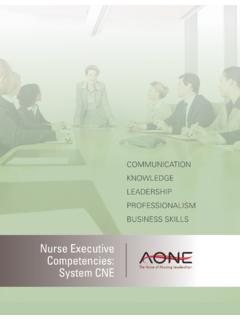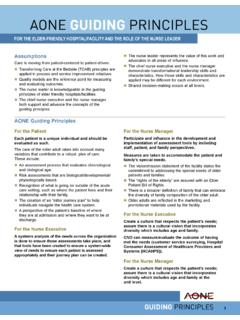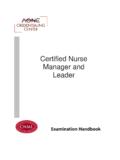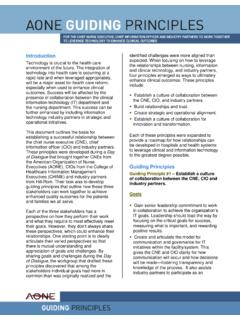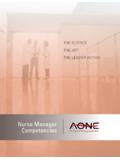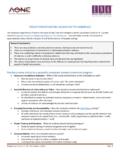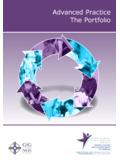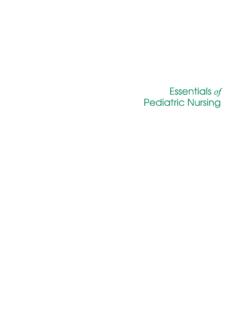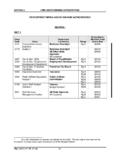Transcription of AONE GuidinG PriNciPlEs
1 aone GuidinG PriNciPlEs To Protect Patients from Reckless Behavior by Registered Nurses Background Purpose Statement The nurses and caregivers in our health care system This document establishes GuidinG PriNciPlEs for the are on the frontlines of care, serving a special role that identification and mitigation of registered nurses/advanced mandates a high standard of care to ensure a safe practice registered nurses (APRNs) that may act in patient culture. This standard was paramount when manner detrimental to a patient's safety when conducting the leadership of the American Organization of Nurse their professional duties. Executives ( aone ), American Society for Healthcare Risk These PriNciPlEs are based on the tenets of Just Culture Management (ASHRM), and the American Society for espoused by James Reason, which is the development Healthcare Human Resources Administration (ASHHRA) of a trusting environment in which people are encouraged met to discuss how this process could be improved.
2 (even rewarded) for providing safety-related information;. Although rare, headlines remind us that criminal behavior commitment to excellence; and establishment of guidelines does occur that requires us to be ever vigilant in our that foster personal accountability as well as corporate self- protection of patients. It was critical that these three regulation in matters of safety (Reason, 1997). We also organizations collaborate to develop GuidinG PriNciPlEs recognize the body of work by David Marx and his analysis for further discussion and use by respective members of behavioral concepts important to understanding the inter- nurse leaders, health care risk managers, and human relationship of discipline and patient safety (Marx, 2001).
3 Resource professionals. The Just Culture model describes three types of behavioral categories that we can expect in the occurrence of an adverse The resulting GuidinG PriNciPlEs include suggested event. Human error is an inadvertent action slip, lapse, practices as a starting point for organizations interested or mistake (Marx, 2001). At-risk behavior is a behavioral in reviewing their preparedness to deal with a provider choice that increases risk where risk is not recognized or is who may act in an at-risk or reckless manner. The exhibits mistakenly believed to be justified (Marx, 2001). Reckless attached are intended as examples to assist organizations behavior is a behavioral choice to consciously disregard a in building on their own knowledge and practices.
4 Substantial and unjustifiable risk (Marx, 2001). We will focus It is our intent that each health care organization will on at-risk behaviors and reckless behaviors. consider these approaches as a starting point and use As leaders of our professional organizations and on their own substantive knowledge, expertise, and best behalf of the patients we serve, we commit the experience practices to build the details of processes appropriate for and resources of our individual organizations to create their organization. awareness and discussion to ensure the safety of patients in our care. We believe that the following PriNciPlEs can guide us in this process. Part I: Effective Recruitment, Screening Human Resources screens applications and conducts and Hiring the initial candidate interview.
5 The Nurse Director and/or appropriate staff conduct the It is essential that the recruitment, screening and hiring next or second candidate interview. process for clinical staff/nurses is effective in order to protect patients and create a safe clinical environment Human Resources conducts the candidate background for staff. The organization's health care human resource check, which includes the following: professional is an important resource as you consider yy Drug screen to test for illegal substances clinical candidates. and prescription drugs (barbiturates, opiates, amphetamines, marijuana/hashish; hallucinogens). The following are Elements of the Recommended Hiring Process: yy Criminal background check. yy Verifies that candidate is NOT on the Medicare Human Resources reviews and approves candidate Exclusion list (footnote).
6 Application form prior to position posting. yy See Appendix for sample applicant reference form. 1 GuidinG PriNciPlEs yy If required by the state, obtains a copy of candidate Support and consistently communicate the processes fingerprints. If not required by the state, consider essential to creating a safe patient and work obtaining as part of the hiring process. environment, even if they are time-intensive. yy Request a copy of candidate's last performance Engage those involved in efforts to continuously evaluation. improve the onboarding process. Human Resources performs the following as part of the hiring process: Part III: Monitoring Behavior yy Verifies candidate's education and training. Monitoring for high-risk ( , at-risk or reckless behavior).
7 Yy Verifies candidate's Licensure with the relevant State requires a collaborative approach including Human Board of Nursing. Resources, Nursing Leadership, and Risk Management yy Queries the National Practitioner Data Bank (NPDB) professionals. Hospitals/health care organizations should for advanced practice registered nurses. establish a defined mechanism to monitor, investigate and yy Human Resources conducts two to three candidate report at-risk or reckless behaviors. reference checks with former employers. Questions The following are components of a process to monitor may include but are not limited to: recommend high-risk behaviors of clinical staff: adding disclaimer Under advice of legal counsel.. Would you rehire candidate X?
8 Yes No Establish appropriate job expectations and performance criteria. If not, why? (Factors to consider include attention to safety, interpersonal relations, compliance, Establish mechanisms for proactive performance attendance, professional practice issues.) review that includes behavioral performance. yy Human Resources, after consultation with nursing Establish a process to monitor and evaluate clinical hiring staff, decides to hire or not hire the candidate. staff transfers to ensure that registered nurses with high-risk behavior don't move within the facility as a yy Human Resources communicates the hiring decision way to avoid detection. and terms to the candidate. Ensure that there are multiple mechanisms for employees and others to report suspicious or high-risk Part II: Ensuring Effective Clinical behavior.
9 Onboarding Establish mechanisms that provide ongoing All newly hired clinical staff/nurses should have a defined assessment and monitoring of permanent and probationary period during which goals are set to establish temporary staff for quality and safety of care ( , and assess competency. The length may vary, though incident reports, sentinel events, complaints, 90 days is customary. A defined competency based grievances, near miss data, claims data, quality audits, orientation program, supervised by a registered nurse, is and chart audits). recommended. Identify triggers that will alert staff of the need for further investigation of events that cause harm ( , Clinical staff is one of the most important assets of any discrepancies in medication administration, adverse health care organization.)
10 In order to attract clinical staff, it is drug events, and adverse events). important to effectively orient newly hired clinical/nurse staff. The following are elements of an effective onboarding process: Part IV: Assess Culpability Use an onboarding process that is proactive, Upon suspicion or detection of an adverse event that transparent and flexible. could be the result of malicious intent the following actions Engage those involved in the process, such as, but not are recommended: limited to: Respond to the patient. Determine if there is an yy Human Resource professionals ongoing threat. Implement strategies to stop the loss or yy Nurse managers mitigate the loss, as appropriate. yy Senior executives Notify the Risk Management Department and/or appropriate personnel pursuant to organizational yy Health care risk managers policies and procedures.

